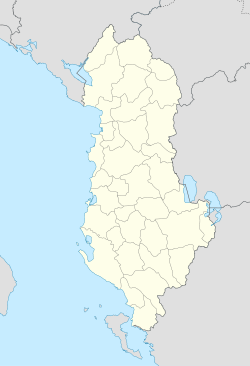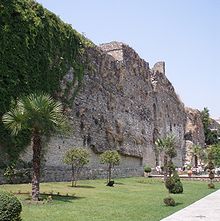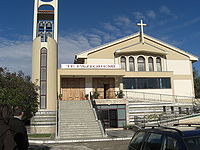- Elbasan
-
Elbasan — Municipality and City — 
SealCoordinates: 41°06′N 20°04′E / 41.1°N 20.067°ECoordinates: 41°06′N 20°04′E / 41.1°N 20.067°E Country Albania County Elbasan County District Elbasan District Founded 15th century Government - Mayor Qazim Sejdini (SP)[1] Area - Total 1,290 km2 (498.1 sq mi) Elevation 150 m (492 ft) Population (2001) - Total 87,797 Time zone Central European Time (UTC+1) - Summer (DST) CEST (UTC+2) Postal code 3001-3006 Area code(s) 054 Website www.elbasani.gov.al Elbasan (Albanian: Elbasan or Elbasani) is a city in central Albania. It is located on the Shkumbin River in the District of Elbasan and the County of Elbasan, at 41°06′N 20°04′E / 41.1°N 20.067°E. It is one of the largest cities in Albania, with a population of around 100,000 (2003 estimate).
Before the Second World War, Elbasan was a city with a mixture of eastern and medieval buildings, narrow cobbled streets and a large bazaar. There was a clearly defined Christian settlement within the castle walls, a Vlach district on the outskirts of the city and several fine mosques and Islamic buildings. At the time the population was about 15,000 people.
The English journalist J.D. Bourchier, then the Balkan correspondent of The Times, records that on a visit in 1911 he saw:
"The population celebrating Bairam in central space: wonderful primitive merry-go round with gypsy minstrels (flute and drum), pushed round by the men with poles; also a cartwheel poised on a tree top; pekhilvans wrestling, mostly refugees from Dibra, thus gaining a precarious livelihood."[citation needed]
Contents
History
Ancient and early Byzantine periods
In August 2010 archaeologists discovered two Illyrian graves near the walls of the castle of Elbasan.[2] Elbasan came into prominence in the Roman period, when it was known as Mario Scampa.[3] The Romans built a substantial fortress here, about 300 square meters, protected by towers. In the third and fourth centuries, it became known as Hiskampis.[citation needed] It had developed as an important trade and transport centre near the junction of two branches of the Via Egnatia coming from Apollonia and Dyrrachium.
It took part in the spread of Christianity along the Via, and had a bishop, cathedral and basilicas as early as the fifth century. As a town in a wide river valley it was vulnerable to attacks once the legions were withdrawn but Emperor Justinian made an effort to improve the fortifications. The city survived attacks by the Bulgars and Ostrogoths and was mentioned in the work of Procopius of Cæsarea.
Ottoman period
Further information: Sanjak of ElbasanThe site seems to have been abandoned until the Ottoman army built a military camp there, followed by urban reconstruction under Sultan Mehmet II in 1467. Mehmet constructed a massive four-sided castle with a deep moat and three gates. He named it Elbasan, meaning 'crushing fist' in Turkish.[citation needed] It became the seat of Sanjak of Elbasan, a centre of Ottoman urban civilisation over the next 445 years. By the end of the 17th century it had 2,000 inhabitants. The fortress was dismantled by Reshit Pasha in 1832. In 1864, the Sanjak of Elbasan became a part of Monastir Vilayet. At the beginning of the 20th century it was estimated that 15,000 people lived in Elbasan.[4]
In 1909, after the Young Turks revolution in Istanbul, an Albanian National Congress was held in Elbasan to study educational and cultural questions. The delegates, all from central and southern Albania, endorsed the decision of the Congress of Monastir, which was held in Monastir (modern Bitola, Republic of Macedonia) to use the Latin alphabet rather than the Arabic script in written Albanian.
Albania
The very first teachers' training college in Albania, the Shkolla Normale e Elbasanit, was established in Elbasan.
The Muslim majority of Elbasan opposed the installation of Prince Wied in 1914.[citation needed] Elbasan was occupied successively by Serbs, Bulgarians, Austrians and Italians between 1915 and 1918. The Bulgarian army occupied Elbassan on January 29, 1916, during Bulgarian occupation of Albania[5] In March 1916 the army of Austria-Hungary took over control of Elbassan [5] From June 1916 to March 1917 Stanislav Kostka Neumann fought with the Austrian army there and called his war memoirs about the occupation in Elbasan.[6] Industrial development began in the Zogist period when tobacco and alcoholic drinks' factories were established.
The city was also noted for its good public buildings, advanced educational provisions, public gardens and timber-built shops. There was much wartime damage, which was followed by an intensive programme of industrial development in the Communist period that boosted the city to around 75,000 inhabitants. The culmination of this process was the construction of the huge Steel of the Party (Albanian: Celiku i Partise) metallurgical complex outside the city, in the Shkumbini valley, built with Chinese assistance in the 1970s. It was emphatically called "The Second National Liberation of Albanian" by Enver Hoxha. The cost of the complex in environmental impact was high for the Shkumbin valley.[citation needed]
Culture and religion
Elbasan has been occupied by several different groups, including the Serbs, Bulgarians, Austrians and Italians. Elbasan remained a center of Islam in Albania even after the Ottoman occupation. After the 1908 Congress of Monastir (in modern Bitola, Republic of Macedonia) decided to use the Latin alphabet for the written Albanian language, Muslim clerics influenced by the Young Turks held various demonstrations in favor of the Arabic script in Elbasan.
In the middle of the city is found the Saint Mary Orthodox Church. The church was built in 1830 on the foundations of an older church, which had partially burned in 1819. Paintings and frescoes of Onufri, restored by David Selenicasi and Kostadin Shelcani can still be seen. The church has been an important religious and cultural center for the Albanian language. Teodor Haxhifilipi, Kostandin Kristoforidhi, and Aleksandër Xhuvani have served in the church. They are the authors of translations into Albanian of many psalms. The church building served as the first Albanian school of Elbasan in modern times, which opened in 1908.[7]
Other orthodox churches in the Elbasan District include the Mameli church (built in the 17th century), the Saint Nicholas church (Albanian: Shen Kolli) in Shelcan (built in 1554), the Saint Nicholas church in Valesh (built in 1604), the Saints Cosmas and Damian church in Sterstan (built in the 18th century), the Saint Michael (Albanian: Shen Mehilli) church in Shalës (built in the 17th century), the Saint Mary church in Dragot (built in the 18th century), the Saint Nicholas church of Elbasan (17th century), and the Elbasan Saint Athanasius church of Elbasan (built in 1554).
About 7 km away from Elbasan there is an old monastery and orthodox church where notably Saint Jovan Vladimir was buried until 1995 when his remains were transferred to the Orthodox Cathedral in Tirana, being brought back to the monastery only for his feast days.[8]
Elbasan is home to the National Autocephalous Albanian Church (Albanian: Kisha Autoqefale Kombetare), a relatively new Orthodox Autocephalous church that split from the Albanian Orthodox Church in 1995. Father Nikolle Marku is the leader of the new denomination.[9]
Elbasan is also home to a Uniat Catholic church.[10]
Elbasan has four museums:[11]
- Ethnographic Museum (1982) held in a 18th century building.
- “Kostandin Kristoforidhi” house (started as a museum in 1978),
- Shkolla Normale Museum,
- War Museum
Elbasan is the home to the Summer Day festivities, a pagan feast celebrating the end of winter and the coming of summer. Ballokume, cookies made from butter and corn wheat is the traditional dish served in this day. Since 2004, it has become a national holiday being celebrated in Tirana on a Monday in mid-March.
Economy
Industrial development began during the Zog regime with the production of tobacco and alcoholic beverages, and culminated during the communist regime. The city gained prominence after the Chinese built a steel mill in 1974. There were also other industries operating in the city during the communist regime, and as a result the city now suffers from pollution.
Mayors
Mayors of Elbasan[12] Alush Saraçi
Fuad Bicaku
Hysen Hostopalli
Tajar Malesi
Kasem Sejdini
Lef Nosi
Behexhed Hydi
Hafez Musa Ali Basha
Rustem Ymeri
Hasan Bicaku
Ahmet Dakli
Qemal Karosmani
Ymer Saraçi
Teofik Bekteshi
Abdyl Dylaveri1912–1913
1913–1915
1915–1916
1917–1918
1919–1924
1924–1924
1925–1928
1928–1929
1929–1930
1933–1934
1937–1939
1939–1939
1939–1942
1942–1943
1943–1944Thanas Kononi
Spiro Todri
Ilia Trandafili
Qemal Shkalla
Riza Kazazi
Liri Hakani
Viktor Dodbiba
Qazim Kafexhiu
Katina Topuzi
Stavri Gostivishti
Hamit Gjata
Mit’hat Kokunja
Xhevdet Fejzo
Kujtim Musaj
Nezir Krasniqi????–????
????–????
????–????
????–????
????–????
????–????
????–????
????–????
????–????
????–????
????–????
????–????
????–????
????–????
????–????Hamdi Gerlica
Breatrice Ballici
Ibrahim Pajenga
Elham Hasani
Besnik Ekmekciu
Durim Hushi
Hyqmet Kotherja
Emine Sadiku
Emin Et’hem Haxhiademi
Engjell Dakli
Hysen Domi
Ardjan Turku
Qazim Sejdini????–????
????–????
????–????
????–????
????–????
????–????
????–????
????–????
1992–1996
1996–2000
2000–2003
2003–2004
since 2007Notable people
- Serxhio Abdurahmani, football player
- Dervish bej Biçaku, signatory of the Albanian Declaration of Independence
- Shefqet bej Daiu, signatory of the Albanian Declaration of Independence
- Kostandin Kristoforidhi, translator in Albanian of the New Testament
- Qemal bej Karaosmani, signatory of the Albanian Declaration of Independence
- Lef Nosi, signatory of the Albanian Declaration of Independence
- Sedefkar Mehmed Agha, 16th century architect
- Dhimitër Shuteriqi, writer and critic
- Bexhet Jolldashi, football player
See also
- Clouds of Smoke (documentary film)
- Elbasan script
- History of Albania
- List of cities in Albania
References
- ^ "20/02/2007 Të nderuar miq!". 2007-02-20. http://albania.dyndns.org/Presse/2007/20022007.htm.
- ^ Popja, Fatmir. "Elbasan, zbulohen dy varre ilire në muret e kalasë". http://bw.balkanweb.com/kultur%C3%AB/2691/elbasan-zbulohen-dy-varre-ilire-ne-muret-e-kalase-45067.html. Retrieved 9 August 2010.
- ^ The Roman Republic and the Founder of the Empire, T. Rice Holmes, n.d. ISBN-1115402870, page 121, "Scampa, now Elbasan"
- ^ Raza, Moonis (1906). Geographical Dictionary Of The World In The Early 20th Century. Logos Press. p. 588. http://books.google.com/books?id=N2tvuRaSPzAC&pg=PA588&dq=sanjak+elbassan&hl=en&ei=Xrk1Tpy9LIy68gOvpaShDg&sa=X&oi=book_result&ct=result&resnum=9&ved=0CFcQ6AEwCA#v=onepage&q=sanjak%20elbassan&f=false. Retrieved 31 July 2011. "...Pop estimated at 15,000"
- ^ a b Pearson, Owen (2004). Albania and King Zog: independence, republic and monarchy 1908-1939. I.B.Tauris. p. 103. ISBN 9781845110130. http://books.google.com/books?id=3_Sh3y9IMZAC&pg=PA103&dq=Themistokli+Germenji&hl=en&ei=rtnSTPpZ6JLiBuHYoaIP&sa=X&oi=book_result&ct=result&resnum=2&ved=0CCoQ6AEwAQ#v=onepage&q=led%20by%20Themistokli%20Germenji&f=false. Retrieved January 11, 2011. "January 29th; ... Bulgarian troops had also crossed Albanian frontier, and Elbassan in central Albania was occupied by a company of the 23rd Bulgarian Infantry Regiment under Captain Serafimov"
- ^ (Czech) S.K. Neumann: Elbasan, družstevní nakladatelství "Kniha", knihovna socialistické kultury, svazek III., Praha 1922
- ^ From the Saint Mary website
- ^ Milosavljević, Presbyter Čedomir (September 22, 2007). "Св. Јован Владимир" (in Serbian). Pravoslavna Crkvena Opština Barska. http://www.pravoslavnacobar.org/Sv.Jovan%20Vladimir.htm. Retrieved 2008-01-03.
- ^ Church's official website
- ^ In the official website under "Per qytetin" "Vende Turistike"
- ^ In the official website under "Per qytetin" "Vende Turistike"
- ^ "Pushteti vendor ne qytetin e Elbasanit". Municipality of Elbasan. http://www.elbasani.gov.al/elbasani/Per_Bashkine/Pushteti_vendor_ne_qytetin_e_Elbasanit.php.
External links
- Elbasan on Virtual Tourist
- Municipality of Elbasan (official website) (Albanian)
- Photos
- ALBoZONE: Cities of Albania
- Elbasan script
- Elbasan web
- Elbasan's football team
- oraret e Elbasanit, Elbasan Timetables
- News about Elbasan (Albanian)
Municipalities of Elbasan County Capital: Elbasan Elbasan District 
Gramsh District Librazhd District Peqin District Elbasan Landmarks Elbasan Castle · Elbasan Ethnographic Museum · Kostandin Kristoforidhi House · Shkolla Normale Museum · Elbasan War Museum · Elbasan Mosque · Elbasan Clock TowerPlaces of worship Basilica on Tepe's Hill · Basilica on Tepe's Hill · King Mosque · Namazgjah · Naziresha Mosque · St. Mary's ChurchCities in Albania Bajram Curri · Bajzë · Ballsh · Berat · Bilisht · Bulqizë · Burrel · Cërrik · Çorovodë · Delvinë · Divjakë · Durrës · Elbasan · Ersekë · Fier · Fushë-Arrëz · Fushë-Krujë · Gjirokastër · Gramsh · Himarë · Kamëz · Kavajë · Këlcyrë · Klos · Konispol · Koplik · Korçë · Krastë · Krrabë · Krujë · Krumë · Kuçovë · Kukës · Kurbnesh · Laç · Leskovik · Lezhë · Libohovë · Librazhd · Lushnjë · Maliq · Mamurras · Manëz · Memaliaj · Orikum · Patos · Peqin · Përmet · Peshkopi · Pogradec · Poliçan · Prrenjas · Pukë · Reps · Roskovec · Rrëshen · Rrogozhinë · Rubik · Sarandë · Selenicë · Shëngjin · Shijak · Shkodër · Sukth · Tepelenë · Tirana · Ulëz · Urë Vajgurore · Vau i Dejës · Vlorë · Vorë

Other towns Church ruins, Belsh · Church ruins, Bixëllenjë · Grabovë Church · Church ruins, Mamël · Annunciation Church, Mjekës · Clock Mosque, Peqin · Church ruins, Selvias · St. Nicholas' Church, Shelcan · St. Jovan Vladimir's Church, Shijon · Qafthanë Church, Urakë · Qafthanë Cave Church, Urakë · St. Paraskevi's Church, ValleshCategories:- Cultural Monuments of Albania
- Elbasan
- Populated places in Elbasan County
Wikimedia Foundation. 2010.





